Inspired by some conversation in the comments, I decided to compile a comprehensive list of sunk battleships. Criteria for inclusion on this list are: the vessel must be a pre-dreadnought or dreadnought battleship or battlecruiser,1 and have been lost due to either enemy action or accident. Ships that were scuttled do not count unless in sinking condition,2 nor do ships sunk as targets. I have attempted to include ships whose attempts to sink were interrupted by the harbor bottom, even when they were subsequently put back into service, but it is likely that I missed one or two of these. These ships are denoted by asterisks. All told, I managed to get 90 entries, although one ship is on here twice.
An explanation for some of the column headers: I've used date laid down as the best proxy I can for the age of the design, because launch date can vary greatly depending on how the building goes. Some of the ships were extensively refitted before their loss, but I wanted to keep my data relatively clean, so I ignored that. Main and Secondary Causes were things that, in my view, led to the ship being on the bottom. Main Cause is the best answer I can come up with for "why did the ship actually sink?". Secondary cause is either the reason the main cause happened (in the case of internal explosions) or something that contributed significantly to the ship's loss, either by setting up the conditions for the main cause3 or as a major source of additional damage.4 This is inherently somewhat subjective, but I wanted to have reasonably consistent data instead of a paragraph on each ship to capture all of the nuances. Overall, I'm pretty happy with the result. Delivery is the source of the attack, particularly for torpedoes. Op? is to denote ships that were operational as warships at the time of loss, as opposed to battleships that were being used as barracks, targets, or some other non-warship function.
| Name | Country | Laid Down | Lost | Main Cause | Sec Cause | Deliv | Op? |
|---|---|---|---|---|---|---|---|
| Yashima | Japan | 1894 | 1904 | Mine | Y | ||
| Hatsuse | Japan | 1898 | 1904 | Mine | Y | ||
| Petropavlovsk | Russia | 1892 | 1904 | Internal Explosion | Mine | Y | |
| Poltava* | Russia | 1892 | 1904 | Internal Explosion | Shellfire | Land | Y |
| Pobeda* | Russia | 1899 | 1904 | Shellfire | Land | Y | |
| Retvizan* | Russia | 1899 | 1904 | Shellfire | Land | Y | |
| Navarin | Russia | 1890 | 1905 | Mine | Shellfire | Y | |
| Sissoi Veliky | Russia | 1891 | 1905 | Torpedo | Shellfire | Surf | Y |
| Oslyabya | Russia | 1895 | 1905 | Shellfire | Y | ||
| Borodino | Russia | 1900 | 1905 | Internal Explosion | Shellfire | Y | |
| Imperator Aleksandr III | Russia | 1900 | 1905 | Shellfire | Y | ||
| Knyaz Suvorov | Russia | 1901 | 1905 | Torpedo | Shellfire | Surf | Y |
| Mikasa* | Japan | 1899 | 1905 | Internal Explosion | Accident | Y | |
| Montagu | Britain | 1899 | 1906 | Wrecked | Y | ||
| Iena | France | 1898 | 1907 | Internal Explosion | Accident | Y | |
| Liberte | France | 1902 | 1911 | Internal Explosion | Accident | Y | |
| Bulwark | Britain | 1899 | 1914 | Internal Explosion | Accident | Y | |
| Audacious | Britain | 1911 | 1914 | Mine | Y | ||
| Barbaros Hayreddin | Turkey | 1890 | 1915 | Torpedo | Sub | Y | |
| Bouvet | France | 1893 | 1915 | Mine | Y | ||
| Benedetto Brin | Italy | 1899 | 1915 | Internal Explosion | Accident | Y | |
| Majestic | Britain | 1894 | 1915 | Torpedo | Sub | Y | |
| Ocean | Britain | 1897 | 1915 | Mine | Y | ||
| Goliath | Britain | 1897 | 1915 | Torpedo | Surf | Y | |
| Formidable | Britain | 1898 | 1915 | Torpedo | Sub | Y | |
| Irresistible | Britain | 1898 | 1915 | Mine | Y | ||
| Triumph | Britain | 1902 | 1915 | Torpedo | Sub | Y | |
| Gaulois | France | 1895 | 1916 | Torpedo | Sub | Y | |
| Suffren | France | 1899 | 1916 | Torpedo | Sub | Y | |
| Pommern | Germany | 1904 | 1916 | Internal Explosion | Torpedo | Surf | Y |
| Lutzow | Germany | 1912 | 1916 | Torpedo | Shellfire | Scut | Y |
| Regina Margherita | Italy | 1898 | 1916 | Mine | N | ||
| Leonardo da Vinci | Italy | 1910 | 1916 | Internal Explosion | Accident | Y | |
| Imperatritsa Mariya | Russia | 1911 | 1916 | Internal Explosion | Accident | Y | |
| Russell | Britain | 1899 | 1916 | Mine | Y | ||
| King Edward VII | Britain | 1902 | 1916 | Mine | Y | ||
| Invincible | Britain | 1906 | 1916 | Internal Explosion | Shellfire | Y | |
| Indefatigable | Britain | 1909 | 1916 | Internal Explosion | Shellfire | Y | |
| Queen Mary | Britain | 1911 | 1916 | Internal Explosion | Shellfire | Y | |
| Sagami | Japan | 1895 | 1917 | Mine | Y | ||
| Danton | France | 1906 | 1917 | Torpedo | Sub | Y | |
| Cornwallis | Britain | 1899 | 1917 | Torpedo | Sub | Y | |
| Vanguard | Britain | 1908 | 1917 | Internal Explosion | Accident | Y | |
| Kawachi | Japan | 1909 | 1918 | Internal Explosion | Accident | Y | |
| Viribus Unitis | Austria | 1910 | 1918 | Mine | Y | ||
| Szent Istvan | Austria | 1912 | 1918 | Torpedo | Surf | Y | |
| Britannia | Britain | 1904 | 1918 | Torpedo | Sub | Y | |
| France | France | 1911 | 1922 | Wrecked | Y | ||
| Espana | Spain | 1909 | 1923 | Wrecked | Y | ||
| Aflonso XIII | Spain | 1910 | 1937 | Mine | Y | ||
| Jaime I | Spain | 1912 | 1937 | Internal Explosion | Accident | Y | |
| Royal Oak | Britain | 1914 | 1939 | Torpedo | Sub | Y | |
| Bretagne | France | 1912 | 1940 | Internal Explosion | Shellfire | Y | |
| Provence* | France | 1912 | 1940 | Shellfire | Y | ||
| Dunkerque* | France | 1932 | 1940 | Torpedo | Air | Y | |
| Conte di Cavour* | Italy | 1910 | 1940 | Torpedo | Air | Y | |
| Caio Duilio* | Italy | 1912 | 1940 | Torpedo | Air | Y | |
| Littorio* | Italy | 1934 | 1940 | Torpedo | Air | Y | |
| Kilkis | Greece | 1904 | 1941 | Bombing | Air | N | |
| Lemnos | Greece | 1904 | 1941 | Bombing | Air | N | |
| Bismarck | Germany | 1936 | 1940 | Torpedo | Shellfire | Surf | Y |
| Utah | US | 1909 | 1941 | Torpedo | Air | N | |
| Oklahoma | US | 1912 | 1941 | Torpedo | Air | Y | |
| Arizona | US | 1914 | 1941 | Internal Explosion | Bombing | Air | Y |
| Barham | Britain | 1913 | 1941 | Torpedo | Sub | Y | |
| Prince of Wales | Britain | 1937 | 1941 | Torpedo | Air | Y | |
| Repulse | Britain | 1915 | 1941 | Torpedo | Air | Y | |
| Hood | Britain | 1916 | 1941 | Internal Explosion | Shellfire | Y | |
| Nevada* | US | 1912 | 1941 | Bombing | Torpedo | Air | Y |
| California* | US | 1916 | 1941 | Torpedo | Bombing | Air | Y |
| West Virginia* | US | 1920 | 1941 | Torpedo | Bombing | Air | Y |
| Petropavlovsk* | Russia | 1909 | 1941 | Internal Explosion | Bombing | Air | Y |
| Asahi | Japan | 1898 | 1942 | Torpedo | Sub | N | |
| Hiei | Japan | 1911 | 1942 | Torpedo | Shellfire | Scut | Y |
| Kirishima | Japan | 1912 | 1942 | Shellfire | Y | ||
| Gneisenau | Germany | 1935 | 1942 | Internal Explosion | Bombing | Air | Y |
| Mutsu | Japan | 1918 | 1943 | Internal Explosion | Accident | Y | |
| Scharnhorst | Germany | 1935 | 1943 | Torpedo | Shellfire | Surf | Y |
| Roma | Italy | 1938 | 1943 | Internal Explosion | Bombing | Air | Y |
| Fuso | Japan | 1912 | 1944 | Torpedo | Surf | Y | |
| Yamashiro | Japan | 1913 | 1944 | Torpedo | Shellfire | Surf | Y |
| Musashi | Japan | 1938 | 1944 | Torpedo | Bombing | Air | Y |
| Zahringen | Germany | 1899 | 1944 | Bombing | Air | N | |
| Tirpitz | Germany | 1936 | 1944 | Bombing | Air | Y | |
| Ise | Japan | 1915 | 1945 | Bombing | Air | Y | |
| Hyuga | Japan | 1915 | 1945 | Bombing | Air | Y | |
| Kongo | Japan | 1911 | 1945 | Torpedo | Sub | Y | |
| Haruna | Japan | 1912 | 1945 | Bombing | Air | Y | |
| Yamato | Japan | 1937 | 1945 | Torpedo | Bombing | Air | Y |
| Novorossiysk | Russia | 1910 | 1955 | Mine | N |
Of course, I wasn't just going to collect a giant pile of data without doing some analysis on it, although if you'd prefer to do your own, I've attached my spreadsheet here for you to play with.
The obvious first question is what actually killed battleships. If we just take the Main Cause field here, the results look like this:
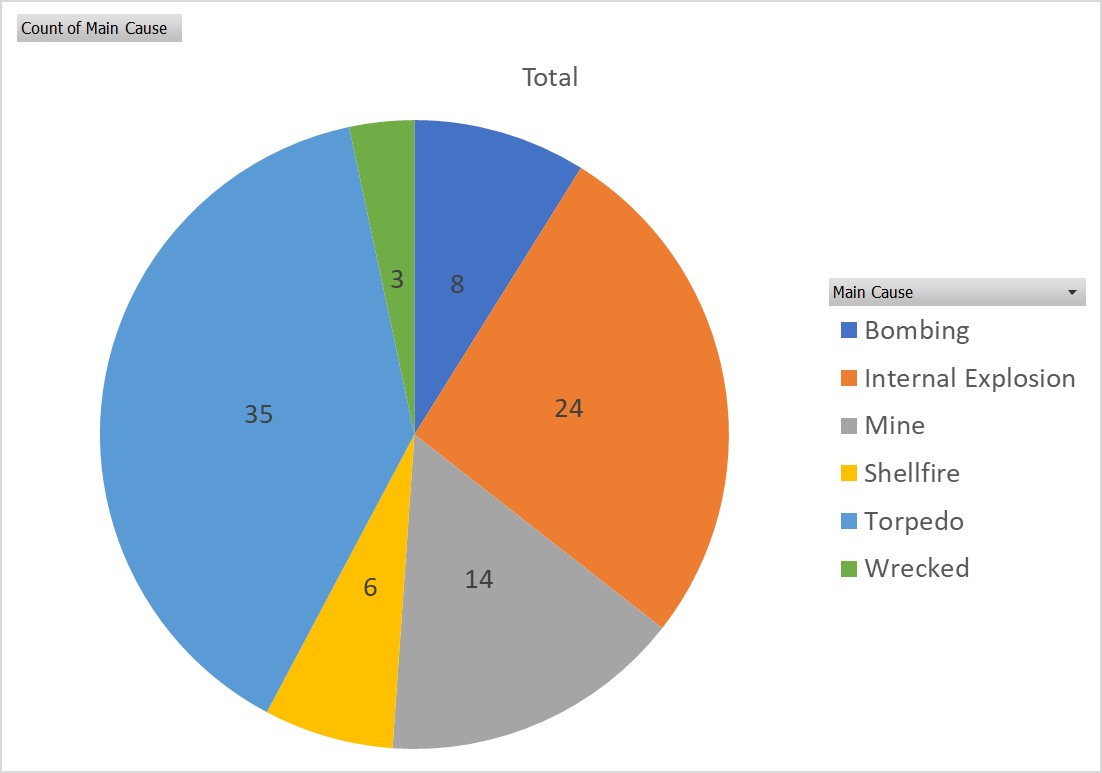
The kills are overwhelmingly dominated by torpedoes and internal explosions, with mines in third and all other causes making up 19% of the total. This isn't particularly surprising. Ships only sink when too much water gets in, and shells and bombs are not particularly good at letting it in, while wrecks were rare. But at the same time, this particular coding scheme obscures as much as it reveals, so I set up another column based on the root cause of the loss instead of the final cause (visible in the attached spreadsheet):
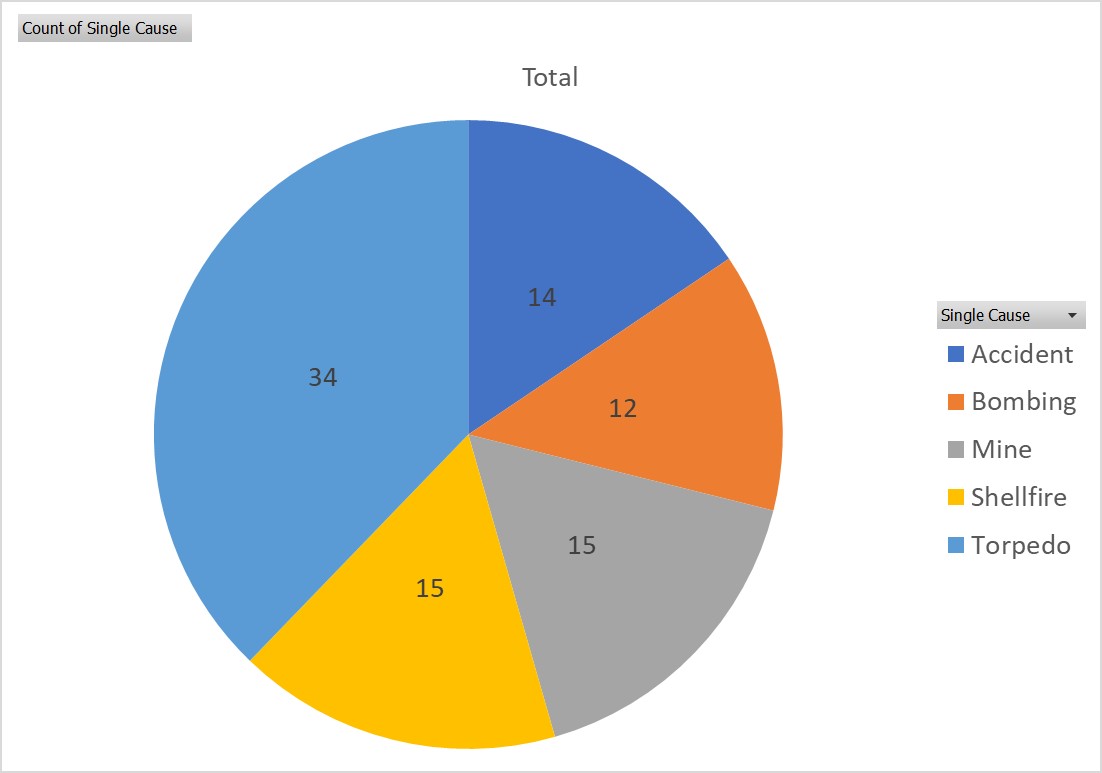
While torpedoes still dominate, shellfire is now tied with mines for second. The gains come mostly from internal explosions, but also a few ships scuttled due to extensive gunfire damage. Accidents and bombing took most of the rest of the internal explosions:

At this point, it's probably worth being more specific. For the following charts, I'm filtering off non-operational ships, as well as ships lost to accidents. This reduces the dataset to only 69 losses, but those are the ones we actually care about.
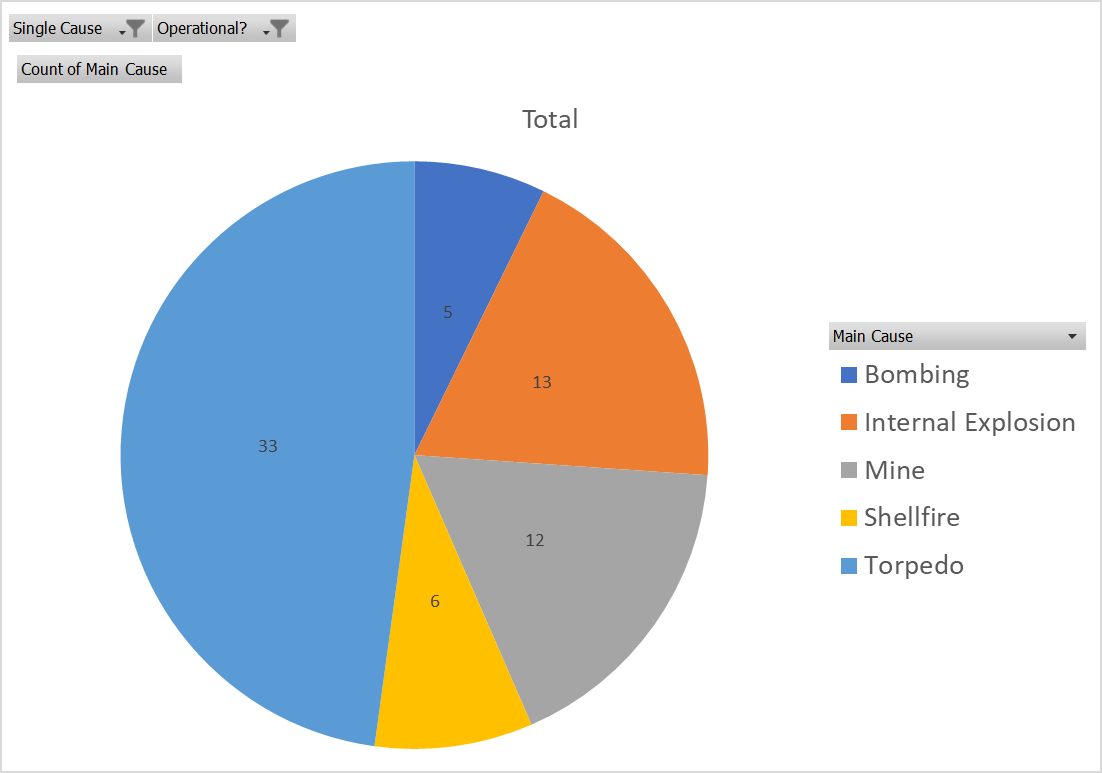
Main Cause - Operational Combat Losses
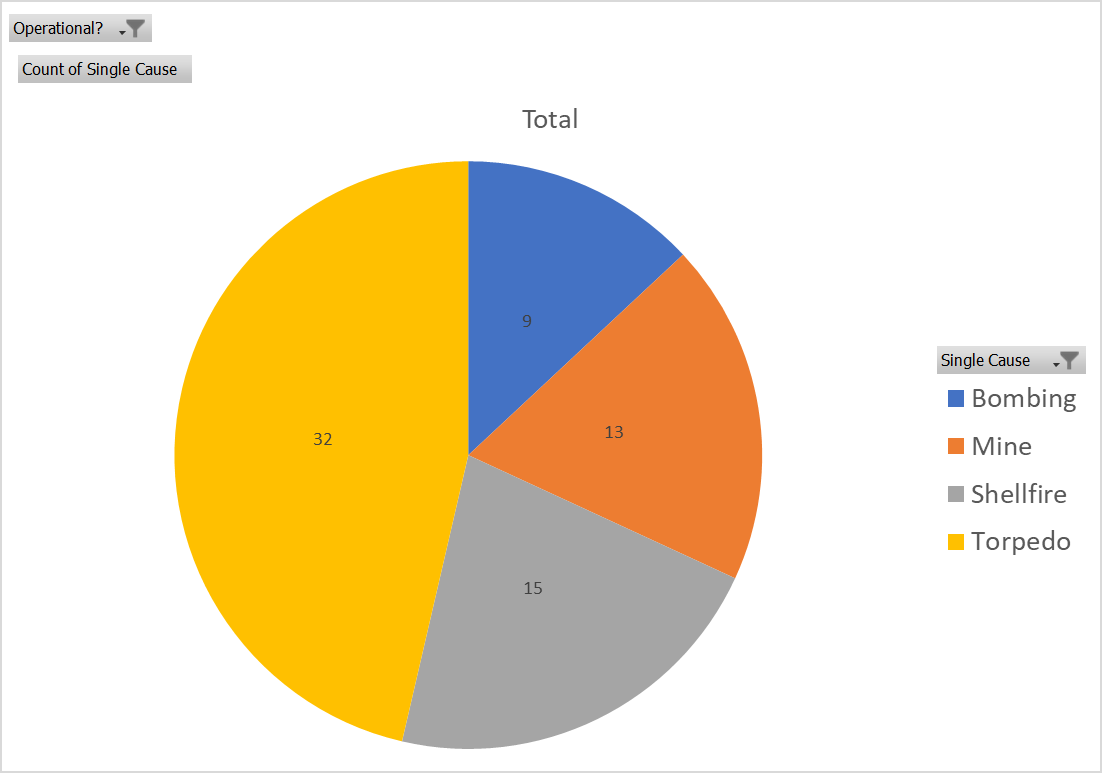
Single Cause - Operational Combat Losses
So underwater damage is the overwhelming cause of loss for these ships, either torpedoes or mines. But torpedoes in particular can come from many different sources, so I made another field to look more specifically at what sort of platform dealt the fatal blow, regardless of method. Small is a small (non-capital) surface ship, to distinguish them from Capital Ships:
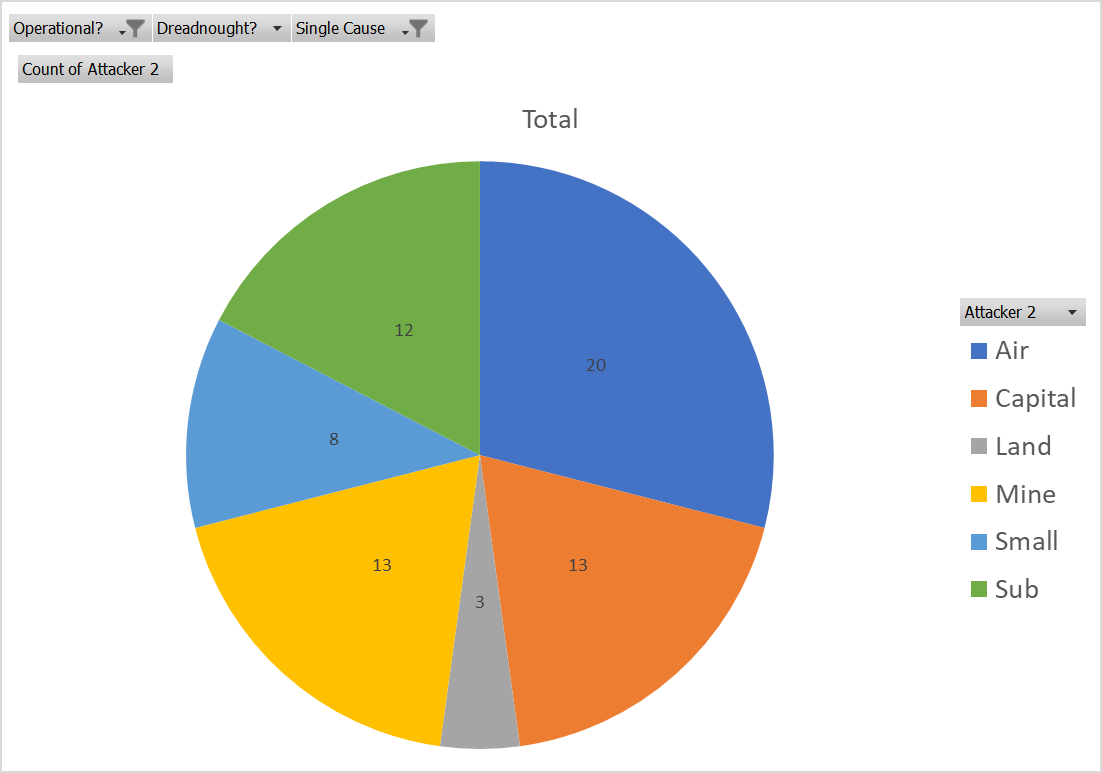
This suggests that rumors of the capital ship's pointlessness are greatly exaggerated. Capital is tied with Mine for second place behind Air, and has a much higher proportion of vessels sunk while at sea, as opposed to in harbor.
Another interesting chart is cause of losses by year. There's a definite shift away from gunnery and towards torpedoes and air attack, but not as radical as you might expect over the battleship's war service:5
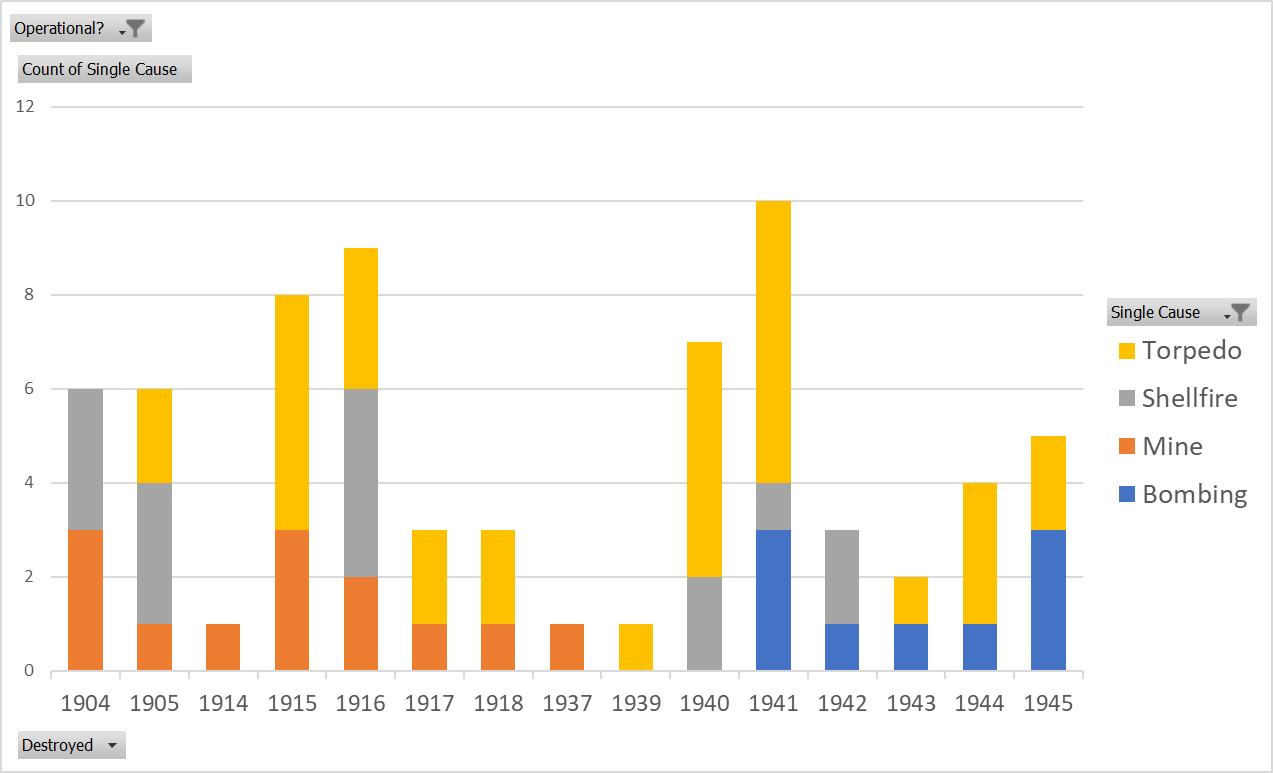
Lastly, it's worth looking at how ships fared by year laid down. I've split this into separate charts for pre-dreadnoughts and dreadnoughts to make it easier to read:
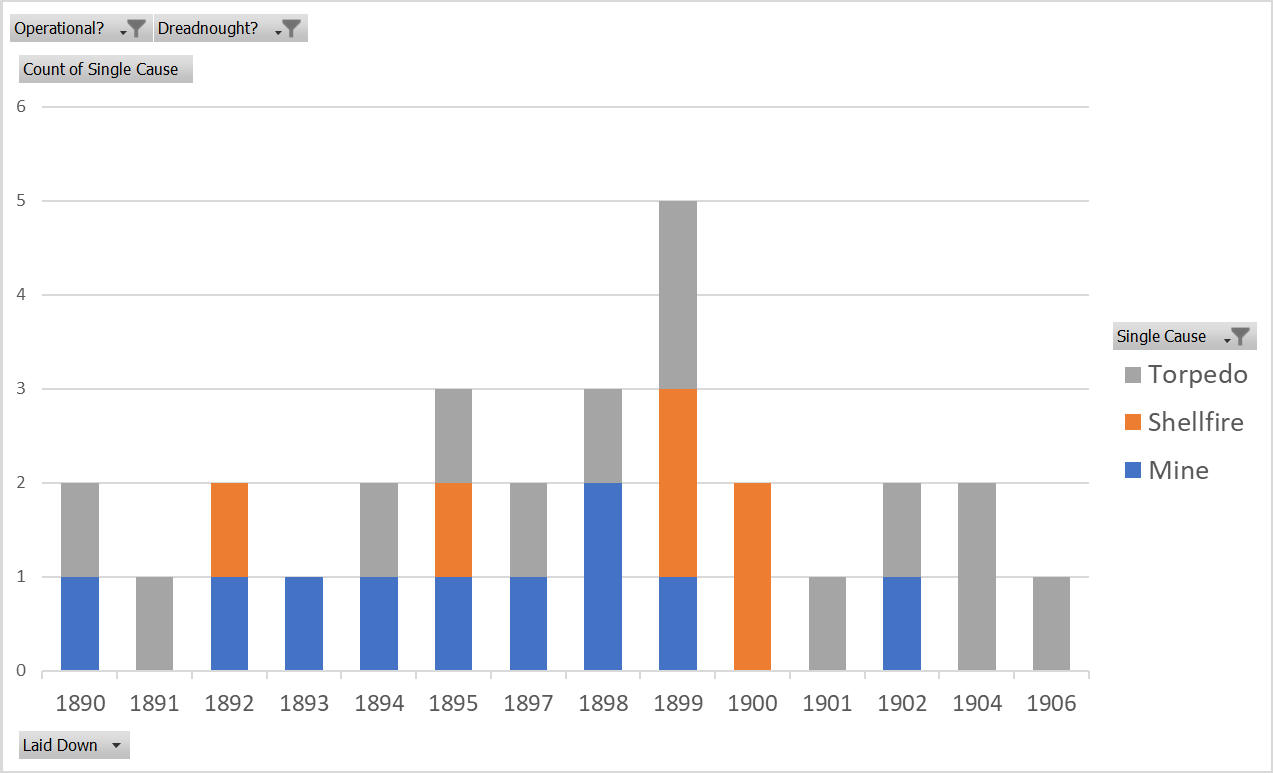
Pre-dreadnoughts
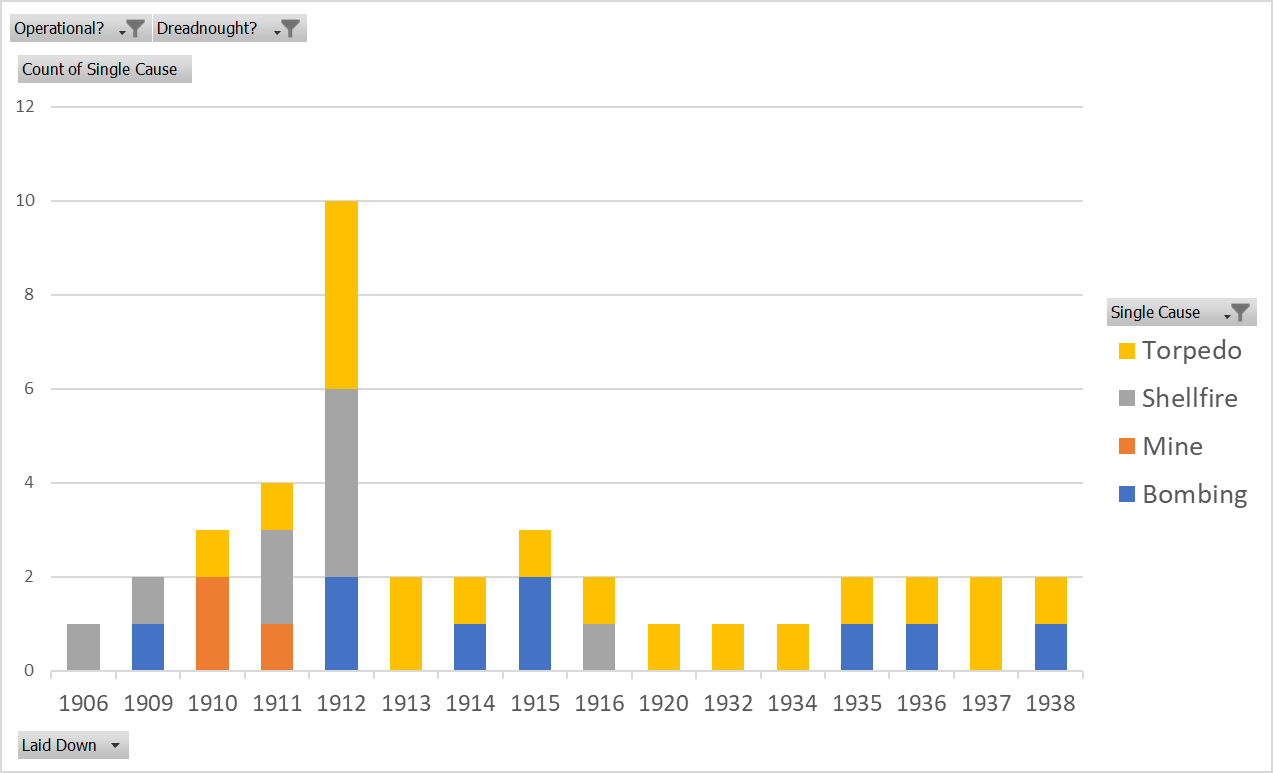
Dreadnoughts
Unfortunately, this is heavily confounded by when the ships were sunk and the methods of attack common then, so the apparent trend towards greater relative resistance to shellfire is in fact illusory.
I'm sure this data has much more to give, but I also think that I've done enough for now. At the very least, this should give a better idea of what actually killed battleships, and what didn't.
1 I thought about including armored cruisers, but decided against it. Also, ships from before the pre-dreadnought era are not included, most notably USS Maine. ⇑
2 So Lutzow, scuttled by the Germans after being pounded to pieces by the British at Jutland, is on the list, but the French ships scuttled at Toulon are not. ⇑
3 For instance, Lutzow was badly damaged by British shellfire before being torpedoed by German destroyers, and definitely wouldn't have been torpedoed if not for the shellfire. ⇑
4 For instance, Yamato was hit by both a lot of bombs and a lot of torpedoes. While the torpedoes probably did more damage, the bombs contributed too. ⇑
5 This graph has an error. I made a mistake in the initial data, and Bismarck is counted as 1940 instead of 1941. ⇑

Comments
I've been waiting for this.
My gut feeling that relatively few BB/BCs were lost in combat to peers seems vindicated?
Fascinating, especially the last two graphs. So no BB/BC launched after '11 was lost to mines, despite their heavy use in WWII? Seems like the compartmentalization worked wonders, but wasn't enough to offset the increased power of torpedoes.
~16% of losses coming from accidents is also remarkable, as is the much higher than expected use of capital torps.
Will have to really dig into this on the weekend. Thanks for doing the work!
You list Bismarck sunk in 1940, while Wikipedia claims 1941.
Also it's amusing that France and Spain had battleships named after their country lost to wrecks in consecutive years.
I've not checked all the data, but I did notice that a typo has Bismarck appearing above Hood in a list sorted by date of loss.
Ah, too slow! Interesting that it jumps out at people like that.
Oops. I put in all of the data by hand, and I've always been terrible at remembering what year that happened in for some reason. I've fixed the table and the spreadsheet, but haven't updated the graph yet.
I was confused for a while wondering what all those surfing torpedoes were.
@Ian
Capital is a significant fraction of total losses, and they're often the "killer of last resort". Don't get used that often, but not unimportant.
@echo
Some of that was better compartmentalization and such. Some was greater caution around mines and better countermeasures. And there were no losses to capital torpedoes. No confirmed hits, ever, although a couple of probables. Surface torpedoes were either destroyers or cruisers.
The text introducing the delivery platform chart kind of makes it sound like it only includes torpedo kills. I also had a moment of "wait, there were that many capital torpedo kills?" before deciding the chart must be all kills.
Looking again now, that chart being just torpedoes would also imply 13 battleships were sunk by CAPTOR mines...
It seems that the employment of battleships changed in WW2 in such a way that mines were less of a factor. Bean might be able to correct me on this, but it seems in pre-war doctrine battleships operated in a far more general purpose role, operating alone or in small fleets and often in shallow waters. In WW2 they seemed to be limited to fleet engagements, and consequently in deeper waters where mines would be less of a factor.
@ADA
Rereading, I saw that, and added a bit of clarification.
@Chuck
Note that only three dreadnoughts were ever lost to mines. First, Audacious, sunk at the beginning of the war by a raider-laid mine, and probably wouldn't have been lost if the crew had been better. (Fairly typical early-war learning experience.) Second, Virbius Unitus, which was actually sunk by a limpet mine, not a normal mine, while in a weird postwar situation. Third, Alfonso XIII, Spanish Civil War. Tiny dreadnought, weird war, probably run badly.
The short version is that the reason for so many mine losses is because the pre-dreads were being used in ways that didn't minimize exposure to mines. Quite a few were hazarded on bombardment missions, most notably off the Dardanelles, precisely because they were seen as expendable. This was not true of the dreadnoughts, although at least a few suffered mine damage on similar missions. Also, most of the pre-dreads had terrible underwater protection. In WWII, there were no expendable battleships, so they weren't risked like they were in WWI.
Wow! I just read the story of the loss of the Novorossiysk/Giulio Cesare. Does anyone else get the impression that the red navy was really sloppy? Sunk by a ten year old mine in your own naval base.
@bobbert
That one surprised me to, as I had never heard of it. then again, when you start with "an Italian battleship in the service of the Russian Navy" one should probably expect a tragic outcome.
Accidents also seem to decrease over time; is this a matter of "some safety precautions get learned over time"? It does seem like some navies have worse accident records than others.
Also, you don't list [i]Valiant[/i] or [i]Queen Elizabeth[/i] -- is that because you didn't judge the limpet mine damage to be sinking? I seem to recall they both hit the harbor bottom.
Pretty much. That came up in the Powder series, which is actually what inspired this post. See there for more discussion.
I actually thought of both of those when putting this list together, but according to wiki, neither actually touched bottom. Raven & Roberts confirms on Valiant, disagrees on QE. Burt says that QE was anchored in "about 8 fathoms of water", and had a draft forward of 41' after the attack. Burt is a more recent work, so I'm going to go with "neither one sunk".
So would it be fair to say that battleship designers should have put more effort into underwater protection and internal structure layout? Or would such a "mine and torpedo optimised" design just result in attackers shifting their tactics to shellfire and bombing?
Well, the job of a battleship is largely to fight other battleships (armed mainly with guns) while some of the task of protecting them from mines and torpedoes is assigned to minesweepers and destroyers. I suppose you could say that it indicates that more resources should have been allocated to those smaller vessels.
It was said that battleships were still needed after the invention of torpedo boats because whilst a torpedo boat could destroy a battleship, they themselves needed protection from enemy battleships that could only be supplied by battleships.
Brings up the question of how would a Navy made up of no surface warships bigger than Cruisers (and even those being light ones primarily torpedo armed) but allowing carriers once aviation became advanced enough have done against a Navy with battleships assuming similar funding, technology level and crew training?
Question about Bismarck - the torpedo listed as primary cause is the airborne torpedo that crippled her, or those from surface vessels at the end of the battle, after her main battery was out of action? If it's the latter, I don't think that fits very well with the battle. The British battleships pounded her and left her defenseless, then the crew scuttled her, and as she was sinking the British gave her a few torpedoes for good measure. But the primary cause of her sinking was because she was scuttled - ie the British could have spared their torpedoes, she would have sunk regardless. Am I misremembering the battle?
I'd say a battleship's job is to establish command of the sea. Consequently, the test of their worth is how well they do against enemy battleships, who have the same job. But they needed to be able to fight (and sink) anything that stands against them - battleship, cruiser, destroyer or fishing boat.
Red Fleet is 3 carriers. Blue Fleet is 1 carrier and 1 battleship. What are the odds? Would the presence of escorts (destroyers and/or cruisers) change the outcome?
@Doctorpat
Remember how many of these vessels were destroyed decades after they were built, facing very different threat environments. Also, there was only limited work that could be done to really improve the TDS, because they were such ferocious consumers of volume. Should they have spent more time and money on tests? Yes, because a lot of ships had serious flaws in theirs. But not a wholesale pivot in designs, partially because how the war shook out saw relatively few battleship-on-battleship engagements (though this wasn't inevitable) and partially because there just wasn't that much they could do.
As for a no-battleship fleet, the battleship was ultimately the platform of last resort. Carriers don't work at night or in bad weather. (More on this Wednesday.) Torpedoes can be very effective, but they're easier to dodge, and it can take a lot to put down a battleship. Take a look at Suriago Strait for that. Probably the best proof of the need for battleships is first vs second nights at Guadalcanal. The US was handled much more roughly when it was just cruisers and destroyers than when SoDak and Washington were around. (Yes, the Japanese had lost Hiei the first night, which made things easier.)
@Alex
It's Dorsetshire's torpedoes. Primary cause is the reason she slipped beneath the waves, and I went with torpedo over scuttling for several reasons. First, I didn't want to have a single category just for this. Second, I'm annoyed with the scuttlers philosophically, and given that nobody has been able to figure this out, ever, I went with the torpedo. Note that most of the graphs were done with Single Cause instead, and that's Shellfire for Bismarck.
That depends on a lot of things. What year it is is probably the big one, along with the tactical scenario. If the battleship can get the carriers within range, they're toast. The ability of the carriers to kill the battleship is questionable, although that again depends on the scenario.
I wasn't aware there's a debate around the issue. Is the question whether they acted too early? After the ship's armament was out of action, and with no hope of help, abandoning it seems a sensible choice.
Interesting. I'm thinking radar would work against the carriers. It helps air defense by providing early warning of strikes, and allows the battleship to engage in bad weather and at night. So, late-war, the combined force has an advantage. However, in the early days of aviation, aircraft weren't sufficiently developed to pose a significant threat (as proved by Mitchell). So when would the balance swing in favor of an all-carrier force?
The question is whether the scuttling was even relevant - was scuttling the decisive factor in sinking the Bismarck (which otherwise would have survived the battle, albeit for a very narrow definition of "survived"), or did it simply accelerate a process that was already inevitable and underway (but which may have been slow to run to completion)? Pro-German propaganda says it's the former, that Nazi engineering was so far advanced of anything the world has seen before or since that they built the only actually unsinkable ship in the history of the world; pretty much everyone and everything else says the latter. But basically all hope of ever actually proving the matter one way or the other was lost when the wreck was found, upright, with the lower hull buried in the ocean floor (so that torpedo damage could not be evaluated).
Barring some major technological or circumstantial advantage (like, say, putting The Idiot Yamaguchi in charge of the 3 CV force), the CV+BB force is probably going to lose the air battle vs. the 3 CV force quite badly - regardless of time period, 3:1 odds is a steep hill to climb. Once that happens their best bet is probably to retreat, unless the BB is already practically on top of the opposing CVs (but the lone CV should definitely head home, if it can). The tricky part is that, depending on the time period, the 3 CV force may also be best served by retreating - especially early on, say in the 20s and 30s. And while a BB worth of radar-laid, VT-fused flak is scary to the all-CV group, about the same time that comes in the BB also has to start worrying about not just the CVs' VB and VT squadrons, but also the VF squadrons doing SEAD with 5" rockets. It is not a "gimme" either way.
Sorry. Wasn't clear. As Philistine says, there's a contingent of Wehraboos that insist that the British didn't sink Bismarck, and that she was instead scuttled. This is an unusually stupid argument even for Wehraboos, but it's pushed me towards classification as "torpedo", particularly because she would otherwise have been the only one marked "scuttled".
My question is why they didn't deploy this miraculous technology on Tirpitz.
Not necessarily. Pre-radar, fighters just weren't very good air defense due to detection issues. The theory was that whoever got the first strike in would win. And while more planes is an advantage even in that case, there's a reasonable chance that the 3-CV force gets surprised. Say that two of the CVs get bombed and are out of action. (Not necessarily sinking, just unable to operate planes.) Now you're in a spot where the battleship, which is a lot harder to kill from the air, becomes a rather potent piece of the puzzle. Note that most battleships took several air groups worth of planes to kill, so deprive them of that, and it's probably a draw.
I'd say they'd be reasonably favored after 1942-ish. Firm around 44 or 45.
Thanks, wasn't aware of the Bismarck "controversy". Seems indeed silly to say she was scuttled by Germans instead of sunk by Brits. What matters is she was defeated in combat, in such a way that her fate was sealed.
To my mind, if there's a solid "sec cause", then "main cause" (ie the immediate cause of sinking) isn't really that important anyway, and I concur that shellfire was the sec in this case. Although I can't help but think that lucky aerial torpedo deserves more credit.
I think this is oversimplifying. The air battle isn't symmetrical, because the 3 red carriers need to sink the battleship before it reaches them. So it's basically 3 red strike groups vs 1 carrier's worth of fighters and a battleship packed with AA. And if the battleship isn't sunk the first time, red air groups would probably be too depleted to try again.
@Bean
What if blue used his carrier differently? Essentially, load her with fighters and keep her close to the battleship while they advance together. The battleship has fighter cover, the carrier has a heavy AA escort.
To win, the red carriers have to strike and sink at least one of them (probably the blue carrier), and still have enough of their air groups survive to come back and finish the battleship. This is why I think radar helps the battleship. The further out the strike is spotted, the more time the blue carrier has to scramble fighters to intercept and disrupt it.
That's it, yeah. Knowing how hard it is to sink naked BBs, how much worse would it be if she has a carrier's worth of fighter cover?
If blue used his carrier differently by loading it to provide air cover to the BB, the odds go up. The big issue is that the BB is unlikely to be able to run down the CVs (typical CV is 32+ kts, typical BB is 28-30). What this means is complicated, depending on the operational situation. If blue is on the defensive, it's a clean win for him, as the CVs go back home. On the offensive, less so, as they'll escape to fight another day.
Again, more on all of this is coming Wednesday.
Wouldn't a pre-radar battle be much more likely to end up with the BB within/near striking range of the CVs before they know what's up?
At night, and/or some nasty weather, and the first each group knows about each other is when they are in sight. At which point the BB is short odds to win.
In the three-on-one scenario, even if we assume the battleship comes within gunnery range of the carriers under cover of storm or darkness, it's highly unlikely to sink more than one of them before the other two scatter and escape. See e.g. the action off Samar. That means, when the sun rises or the storm breaks, you've got two carriers that have a good enough idea where the enemy is to quickly pin it down with the first batch of scout planes. Possibly they know exactly where the enemy is because a couple of screening cruisers were detached to shadow them through the night; see e.g. Denmark Strait.
Two carriers who know where the enemy is vs. one carrier that doesn't, isn't a winning proposition for the one carrier. Even if it's set up for pure defense, it can't keep more than a third or so of its fighters in the air at any time, while the two attacking carriers can put most of their fighters into the first attack wave. I'm not sure you even need bombers for that; just shoot down anything the enemy puts in the air and strafe the deck of the carrier while they try and launch more CAP. Probably you would include some dive bombers just to be sure; it will only take one or two deck hits.
Then it doesn't matter how bad the carriers' air wings were depleted in the first wave, because they only lost fighters. Now it's two CVs worth of bombers against a battleship and a mission-killed carrier.
The point at which you'd trade one extra carrier in your fleet for one more battleship is legitimately debatable, but only for the one-on-one trade. Not one on two or one on three. And if you are making that trade, you may be looking for light battlecruisers rather than heavy battleships - fast enough to chase carriers, powerful enough to sink them, and just tough enough to escape enemy battleships and mark them as targets for your own carriers in daylight.
You won't call them "battlecruisers", of course, because that was a Bad Word after 1921.
@Doctorpat I'm not sure why the presence or absence of radar would be the determining factor there. Even pre-radar aerial scouting, with aircraft limited to daytime, fair-weather operation, is far better than no aerial scouting. That's why navies started building CVs in the first place! And if for some reason aerial scouting is off the table, then Blue has no more idea than Red of what is over the horizon; and the question I have to ask then is, how does Blue find Red's CVs to sneak up on them?
Of course it's not impossible for a BB force to sneak up on a CV force, because that literally happened... Twice, out of all the times various navies attempted it. Both incidents involved weird, unique circumstances, and serious screw-ups at the command level. Building your entire strategy around being able to replicate that at will seems... Deeply unwise.
@John I think you actually could afford more carriers than battleships? What was the relative cost of an Essex Vs an Iowa, or an Illustrious Vs a KGV? How about earlier ships? To be fair, my idea of the relative costs is mostly informed by the RTW2 series Ü. You'd have to factor in the air wing too to get a fair comparison.
If the ability of aircraft to sink battleships at sea was unproven until 1941, it probably wasn't unreasonable for the major navies to hedge their bets, even if carriers were pretty much always the better purchase in hindsight. I would still argue that battleships did have their place throughout the war, not just in night engagements, but also in bad weather, or when you don't want to give ground (e.g. defending your amphibious invasion fleet) - situations where you might trade two carriers for a battleship.
Why is it that you people always end up talking about the subject of upcoming posts? I have a lot more on this for Wednesday.
@John
I don't think we should read too much into Samar, except that God was very much on the side of the USN that day. It shouldn't have turned out like it did.
@Alexander
I do not have a good answer to the question, actually. The best dollar values I have put carriers as somewhat less expensive than battleships, but not a huge amount less. But that doesn't count the air group. There's also industrial issues, which were probably more important during WWII. Battleship armor plants, for instance, are of only limited use for carrier-building, and if they both take big-ship slips and are on the slip for similar periods, then you're not going to get more than one carrier per battleship you give up.
It wasn't trading off battleships for carriers I was really asking about but trading battleships for cruisers where you actually could make 3 for 1 trade offs.
How would say 3 torpedo armed light cruisers do against 1 battleship?
Torpedoes can have an impressively long range, but because of their much lower speed than shells I think the cruisers would lose badly in a long range engagement. I would think that the cruisers would be very dependent on low visibility to get close to the battleship, in much the same way as the battleship would be against the carrier. The difference is that the battleship is still incredibly dangerous at close quarters. You can see that eight battleships were sunk by small ships/torpedo boats, so they aren't in any way immune, but I wouldn't want to pick the cruisers.
Judging just by tonnage, yes. Additionally, battleships need armor, turrets and those cool guns. Then again, carriers need planes and, more importantly I think, trained pilots. Overall, 2 fleet carriers for one fast battleship seems not completely unreasonable.
Based on what I've read and/or heard, spotting and tracking big ships was doable for a competent force. It's unrealistic to assume anyone would send either 3 carriers or a battleship without some escorts and the area would be reasonably well covered by flying boats and/or carrier-based scouts. All in all, each force should have a decent idea where to find the other.
True, in a sprint, but they can't afford to run at flank for days on end. Wouldn't their cruising speeds be more similar?
This assumes 1. there's zero warning of the incoming strike, and 2. shipboard AA is irrelevant. I remember reading a book by a WW2 US naval aviator, where he recalled that strafing a ship (even a destroyer) in a fighter meant a 50-50 chance of survival. Early warning time would be important, which is why radar would probably help the battleship more than it helps the red carriers.
I'm thinking catching fleeing carriers is work for cruisers with some heavy backup. If the carriers' escorts slow down to fight the pursuers, they face the heavy force and are sunk. If the escorts stick with the carriers, then the hunters are allowed into gun range and anyone who slows down is caught by the heavy force and sunk.
Looking forward to Wednesday.
That's an exceptionally risky strategy for both sides. It heavily depends on how good the battleship captain is, and probably also on how good the battleship's intel on the torpedoes is. Part of the problem with Long Lance was that the US couldn't believe the range it was capable of, and didn't take appropriate countermeasures.
My best guess is that you're probably going to trade more like 1:1, maybe 1.5:1, not 2:1, particularly if you're pushing your industry as hard as it will go. The actual monetary cost isn't really important in that case. The bigger issue is industrial limitations. A carrier may have lower tonnage than a battleship, but it's physically of similar size, so you're building it on the same slips. It will probably have similar machinery, so you're looking at the same bottlenecks there, like gear-cutting. I can't say for certain how the man-hours required will compare (and any quick numbers are almost certainly not really comparable) but I doubt that's linear with tonnage, either.
Sort of. At that point, things get determined by range, and the carriers are likely to win that one, too. Air ops take an astonishing amount of fuel (which is why the CVNs exist) to the point that the US carrier standard was 20,000 miles at 15 kts, while battleships were only expected to make 15,000 miles. And both of these were world-leading. A US battleship might be able to outlast someone else's carrier, but in general, the battleship loses a pursuit.
I'm toying with the idea of taking this further, and getting at least some data on damage that battleships survived. I have books that will list every incident of damage to all of the treaty battleships and some earlier ones (depending on nation). The problem is how to turn that into useful numbers. I'm considering something like ranking each incident on a scale of 1-5, 1 being "trivial damage" and 5 being "ship lost". Probably separate rankings for flooding, fire, and mission kills. Might record some extra information about the damage source beyond type. Size (gun caliber, for instance) and approximate number of hits.
Thoughts?
Mission kills, in particular, would be particularly useful information for ships that are notoriously difficult to sink outright.
You say that one ship's on the list twice, but which is it? I can't find any.
I thought it was Peresvet, but it looks like that's only on the list once, and not under that name. Maybe I was wrong about that.